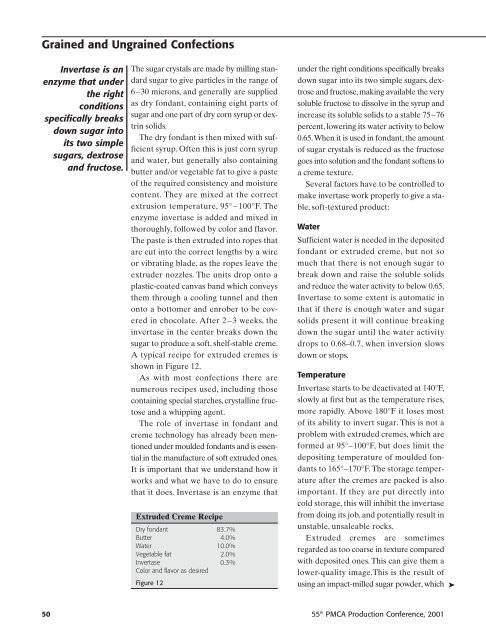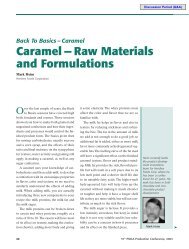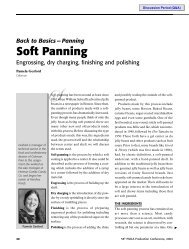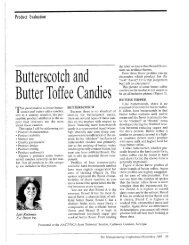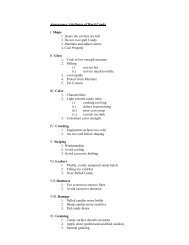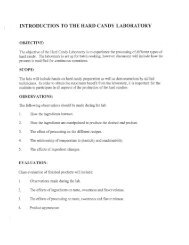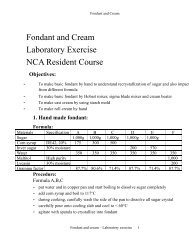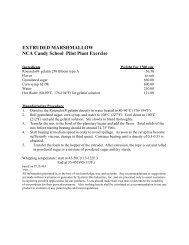2001 Grained and Ungrained Confections - staging.files.cms.plus.com
2001 Grained and Ungrained Confections - staging.files.cms.plus.com
2001 Grained and Ungrained Confections - staging.files.cms.plus.com
You also want an ePaper? Increase the reach of your titles
YUMPU automatically turns print PDFs into web optimized ePapers that Google loves.
<strong>Grained</strong> <strong>and</strong> <strong>Ungrained</strong> <strong>Confections</strong><br />
Invertase is an<br />
enzyme that under<br />
the right<br />
conditions<br />
specifically breaks<br />
down sugar into<br />
its two simple<br />
sugars, dextrose<br />
<strong>and</strong> fructose.<br />
The sugar crystals are made by milling st<strong>and</strong>ard<br />
sugar to give particles in the range of<br />
6–30 microns, <strong>and</strong> generally are supplied<br />
as dry fondant, containing eight parts of<br />
sugar <strong>and</strong> one part of dry corn syrup or dextrin<br />
solids.<br />
The dry fondant is then mixed with sufficient<br />
syrup. Often this is just corn syrup<br />
<strong>and</strong> water, but generally also containing<br />
butter <strong>and</strong>/or vegetable fat to give a paste<br />
of the required consistency <strong>and</strong> moisture<br />
content. They are mixed at the correct<br />
extrusion temperature, 95°–100°F. The<br />
enzyme invertase is added <strong>and</strong> mixed in<br />
thoroughly, followed by color <strong>and</strong> flavor.<br />
The paste is then extruded into ropes that<br />
are cut into the correct lengths by a wire<br />
or vibrating blade, as the ropes leave the<br />
extruder nozzles. The units drop onto a<br />
plastic-coated canvas b<strong>and</strong> which conveys<br />
them through a cooling tunnel <strong>and</strong> then<br />
onto a bottomer <strong>and</strong> enrober to be covered<br />
in chocolate. After 2–3 weeks, the<br />
invertase in the center breaks down the<br />
sugar to produce a soft, shelf-stable creme.<br />
A typical recipe for extruded cremes is<br />
shown in Figure 12.<br />
As with most confections there are<br />
numerous recipes used, including those<br />
containing special starches, crystalline fructose<br />
<strong>and</strong> a whipping agent.<br />
The role of invertase in fondant <strong>and</strong><br />
creme technology has already been mentioned<br />
under moulded fondants <strong>and</strong> is essential<br />
in the manufacture of soft extruded ones.<br />
It is important that we underst<strong>and</strong> how it<br />
works <strong>and</strong> what we have to do to ensure<br />
that it does. Invertase is an enzyme that<br />
Extruded Creme Recipe<br />
Dry fondant 83.7%<br />
Butter 4.0%<br />
Water 10.0%<br />
Vegetable fat 2.0%<br />
Invertase<br />
Color <strong>and</strong> flavor as desired<br />
Figure 12<br />
0.3%<br />
under the right conditions specifically breaks<br />
down sugar into its two simple sugars, dextrose<br />
<strong>and</strong> fructose, making available the very<br />
soluble fructose to dissolve in the syrup <strong>and</strong><br />
increase its soluble solids to a stable 75–76<br />
percent, lowering its water activity to below<br />
0.65.When it is used in fondant, the amount<br />
of sugar crystals is reduced as the fructose<br />
goes into solution <strong>and</strong> the fondant softens to<br />
a creme texture.<br />
Several factors have to be controlled to<br />
make invertase work properly to give a stable,<br />
soft-textured product:<br />
Water<br />
Sufficient water is needed in the deposited<br />
fondant or extruded creme, but not so<br />
much that there is not enough sugar to<br />
break down <strong>and</strong> raise the soluble solids<br />
<strong>and</strong> reduce the water activity to below 0.65.<br />
Invertase to some extent is automatic in<br />
that if there is enough water <strong>and</strong> sugar<br />
solids present it will continue breaking<br />
down the sugar until the water activity<br />
drops to 0.68–0.7, when inversion slows<br />
down or stops.<br />
Temperature<br />
Invertase starts to be deactivated at 140°F,<br />
slowly at first but as the temperature rises,<br />
more rapidly. Above 180°F it loses most<br />
of its ability to invert sugar. This is not a<br />
problem with extruded cremes, which are<br />
formed at 95°–100°F, but does limit the<br />
depositing temperature of moulded fondants<br />
to 165°–170°F. The storage temperature<br />
after the cremes are packed is also<br />
important. If they are put directly into<br />
cold storage, this will inhibit the invertase<br />
from doing its job, <strong>and</strong> potentially result in<br />
unstable, unsaleable rocks.<br />
Extruded cremes are sometimes<br />
regarded as too coarse in texture <strong>com</strong>pared<br />
with deposited ones. This can give them a<br />
lower-quality image.This is the result of<br />
using an impact-milled sugar powder, which ➤<br />
50 55 th PMCA Production Conference, <strong>2001</strong>


